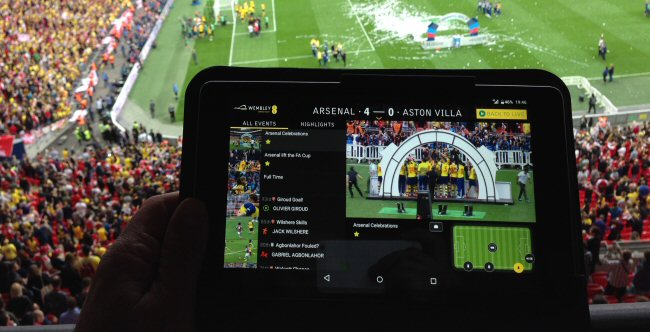Interactive Video Makes Sporting Event Even More Enjoyable
I went to the FA Cup final on Saturday and had the added bonus of experiencing LTE Broadcast in a live environment. Of course I’ve seen numerous demos of the technology at trade shows like Mobile World Congress, but in most cases the content has been recorded.
For the match between Arsenal and Aston Villa, EE teamed up with several partners:
- BBC Sport supplied three live streams: two direct feeds from the stadium coverage and a feed of the broadcaster’s conventional TV programme.
- Technology providers including EVS, Huawei, Intellicore and Qualcomm.
- Wembley Stadium, Opta and others, which supplied live statistics on the game.

Overall, I was impressed with the service. It was a great “second screen” experience at a football match, especially for replays of events such as watching the goals again from different camera angles and discussing any debatable decisions. During the match I wondered how much possession Arsenal had and whether Aston Villa had a shot on target; all of this and more was easily accessed. I really did like the multiple camera angles and I can see many sports fans loving this feature.
The technology allows for two-way interaction. During the game I was asked “Which player has made the most passes in the game so far?” and given a choice of three answers. The screen then told me whether I was right or not. I can see this will open up new ways to engage with users.
There was a noticeable lag in the live feed, probably around 15 seconds. This didn’t bother me as I was there to enjoy the game and soak up the atmosphere, but it may create problems for fans who get caught up in watching a match on their device, rather than enjoying it in person. There was some buffering in loading up replays or changing camera angles, but as the video below shows, they were acceptable. In my experience, the effect on battery life was pretty good. I still had 60 percent charge left by the time Arsenal picked up the trophy. However, I suspect that the performance would have been worse on a loaded network, which wasn’t the case on Saturday.
I’ve been a keen advocate of this technology and pleased to see strong interest in it. This latest trial follows others including Vodafone’s tie-up with Valencia FC in Spain and Telecom Italia’s work with AC Milan. It’s clear that LTE Broadcast will find a use in sports stadiums. But there are other scenarios, such as broadcasting live TV and on-demand streaming, delivering content such as newspapers, magazines, books and TV shows overnight, providing firmware and software updates and powering billboards and digital signage. Telstra is planning to offer LTE Broadcast at major venues in Australia during this year.
The technology is great and it clearly works, as shown by the numerous successful trials. But the lack of commercial deployments reflects uncertainty about how to make money from it. I’m convinced it offers sports fans a great second-screen experience, but I’m not sure whether they’ll pay for it, at least not directly. Perhaps the cost of the service could be absorbed into a match ticket. Operators are probably unwilling to invest millions in upgrading their networks, leaving the most likely scenario joint investment with a venue owner or content owner to share the financial risk.
There’s no doubt that LTE Broadcast will be a useful tool in overcoming network congestion and coping with the explosion in video traffic. I don’t believe devices will pose a problem as many manufacturers now support LTE Broadcast (for example, Samsung’s Note 4 and LG’s G3 support the technology), and the number will continue to grow.
However, broadcast rights may prove a huge stumbling block. Content owners and network operators will have to be clear who owns the rights and whether video can be redistributed live or as a delayed stream to mobile devices. The area is far from straightforward. Take the UK Premier League rights, for example. Live TV rights to selected matches are owned by BT Sport and Sky in the UK, but News International owns the mobile and online rights to show goals almost immediately. BT Sport and Sky can distribute their live TV games to mobile devices. But no game can be transmitted at 3 PM on a Saturday.
The BBC and EE should be applauded for forging ahead with the trial at Wembley. EE has gained a reputation for driving network innovation in the UK, having beaten rivals to launch LTE services in 2012 and deploying LTE-Advanced technology two years later. It seems on course to maintain its reputation with the commercial launch of LTE Broadcast in 2016.
I’d like to thank EE for the kind invitation to attend one of the sport’s greatest events. I was delighted with the result, unlike my colleague Shaun, who is still probably coming to terms with Aston Villa not even producing a shot on target.
 Twitter
Twitter
 Facebook
Facebook
 LinkedIn
LinkedIn
 Email
Email